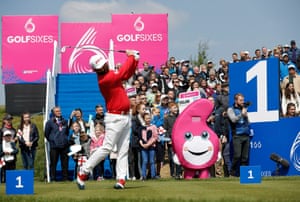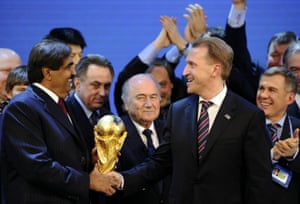The dawn of London 2012. Danny Boyle’s opening ceremony has eviscerated any lingering public cynicism, while Team GB’s arrival and the Arctic Monkeys’ cover of the Beatles’ Come Together has thrust everyone inside the Olympic Stadium off their feet. Now, as the intense whoops and waves of noise finally subside, Sebastian Coe, the organiser of the Games, stands up to urge the millions watching to appreciate the unique power of sport.
“There is a truth to sport,” he insists. “A purity, a drama, an intensity – a spirit that makes it irresistible to take part in, and irresistible to watch.”
You might snigger – when has sport ever been pure? But at the time Coe’s words prove instantly prophetic. That night Britain dives headfirst into a 16-day Olympic bender.
The numbers are extraordinary. Nearly 49 million combined watch the opening and closing ceremonies. More than 17m watch Usain Bolt streak away with the men’s 100-metres final. And another 12m watch the home-made joy of Super Saturday as Greg Rutherford, Jessica Ennis-Hill and Mo Farah win gold over 47 eardrum-shattering minutes. That night, a joke goes viral on Twitter. “A ginger, a mixed-race woman and a one-time Somali refugee walk into a pub – and everyone buys them a drink.”
Across London – sullen, manic, head-down London – everyone appears to carry a permanent smile on their face, as if serotonin has been pumped into the water supply. Writing in the Guardian, Jonathan Freedland even asks whether the Games might “mark the end of Britain’s age of decline”. In the midst of such unfettered joy it seems entirely reasonable.
Coe, it seemed, was right. Sport did have this special capacity to unite, delight and inspire.
Spool forward five years, however, and the picture is nowhere near as rosy. There have been shocking revelations of state-sponsored cheating in Russia, which, according to the Canadian law professor Richard McLaren, “corrupted the London Olympics on an unprecedented scale” – while the sordid tales of corruption in the corridors of Fifa and the International Association of Athletics Federations would put a banana republic to shame.
Meanwhile sport no longer appears quite as irresistible to watch, either. In America, ESPN’s subscriber base has gone from 100m in 2011 to 88m according to the latest Nielsen estimates. Meanwhile Sky, which spends £4.2bn a year to show 126 Premier League games, saw average viewing on its live TV channels fall 14% over the past season.
Increasingly viewers want shorter, sharper, bite-sized chunks of entertainment, on mobile devices too. No wonder some of them are scrambling to revamp their product to avoid being regarded as dull and outdated.
The landscape is changing. So what is sport doing about it?
‘More youthful, more urban’
Last week the head of the International Olympic Committee, Thomas Bach, announced that BMX freestyle and three-on-three basketball would be introduced as events in the Tokyo 2020 Olympics, joining karate, surfing, climbing, skateboard and baseball/softball. The reason was obvious, although Bach didn’t quite put it in these terms: the Games needed to be funked up for a younger generation.
Bach called it a “step-change” and insisted the Games in Tokyo “will be more youthful, more urban and will include more women”. Many inside the Olympic movement wonder what took him so long.
Certainly the IOC has been late to the party. Twenty20 cricket started in 2004 and quickly became the game’s most popular format. Rugby Sevens has been around since 1883, but since receiving the IOC’s stamp of approval in 2009 it has become more relevant than ever. Others, too, are chasing the millennials – realising that if they do not attract new audiences now, in 10 or 20 years’ time they could be increasingly irrelevant.
And that includes staunchly conservative sports, such as golf. As Keith Pelley, chief executive officer of the European Tour, explains: “There are so many wonderful things about our game. But we are not in 1940 now. Every single sport is looking to adapt to a changing society. If you are not, you are going to fall behind.”
Last month the European Tour hosted its first Golf Sixes tournament, featuring 16 two-man teams from 16 countries competing on a specially designed six-hole course at the Centurion Club in St Albans. Each hole had a different theme – the third, for instance, had a long drive competition while the fourth had a 40-second shot clock.
Henni Zuel, who covered the tournament for Sky, believes there were encouraging signs. “Of course it isn’t going to replace the 18-hole game,” she says. “And, as with anything like this, there are going to be things that could be better. But it was really noticeable that it seemed to bring in a younger audience. One of the things I kept hearing from families was that you can take your kids along to six holes, because it is not a massive long walk, and it made for a great atmosphere.”
Athletics is another sport that is tentatively trying to recapture its former glories by slicing and dicing events. The most recent attempt to mix things up is Nitro Athletics – a new format involving six teams of 12 male and 12 female athletes competing in a potpourri of new and old events – which was launched in three Australian cities this year.
There were mixed relays, javelin throwing for distance and accuracy, and a men’s mile where the last-placed runner was eliminated at the end of each of the first three laps of the track.

It attracted a lot of media coverage, largely because Usain Bolt – who was rumoured to have been paid $1m to compete – was there. But not everyone is convinced Nitro Athletics is the way forward. As Jason Henderson, the editor of Athletics Weekly, puts it: “I was left feeling nonplussed. I’m all for experiments and fresh thinking. My problem with Nitro is that not much was earth-shatteringly innovative and some of it even made me cringe.”
His views echo those of agents and race meeting organisers the Guardian has spoken to off the record. They believe Australians came mainly to see Bolt and tick it off their bucket list – rather than for Nitro Athletics.
Another format that has been tried in Britain with some success is street athletics, where fans can get to see the action up close on specially-built tracks in city centres. As Greg Rutherford explains: “I still think the sport is in a bad place, I am not going to lie, but the CityGames showcases the sport in the right way.”
Traditional sports also need to be aware of another factor: the growing popularity of e-sports. The mainstream often dismisses them as being played by spotty adolescents who are deprived of vitamin D and a social life. However Mark Borkowski, a PR and brand expert, insists that is a mistake. “I’m 100% sure that minority sports will suffer because it is about eyeballs and selling product and increasingly that’s what e-sports do,” he says.
He has a further message for any doubters. “Once upon a time darts and snooker were seen as joke sports played in smoky men’s clubs, but now they are respectable. And I know there are a number of big agencies, who represent Hollywood stars, who are paying close attention to e-sports.”
A question of trust
Many problems that sports face are far from fresh. Doping and corruption has festered and lingered for decades. But recently it has developed a fresh twist. Taking performance-enhancing drugs is no longer a black and white issue, but one of ever-darkening shades of grey.
Recently this issue has come worryingly close to home. Who could forget the sight of Bradley Wiggins revelling after adding a London 2012 road race gold medal to his Tour de France triumph – a victory that not only made him Britain’s most successful Olympian but also the runaway winner of the BBC’s Sports Personality of the Year award?

Now Wiggins is fighting to save his reputation amid questions over what was in the jiffy bag delivered and administered to him on the final day of the Critérium du Dauphiné in June 2011 – and whether he might have broken any anti-doping rules at the time. Wiggins is also under pressure on a second front following leaks from the Russian hackers Fancy Bears which showed that he was granted therapeutic use exemptions for the powerful corticosteroid triamcinolone, supposedly for his allergies, before the 2011 and 2012 Tour de France and the 2013 Giro D’Italia. However, the drug – which is illegal to use without a TUE – also has an effect on performance. Wiggins has always maintained he used it to combat pollen allergies and has always denied wrongdoing.
The former professional rider Joerg Jaksche described the effect of triamcinolone as “extreme”, adding: “Your recovery is shorter and the pain you are going through is less. It makes you very skinny. It burns fat. You are going to suffer less. It is the old school of doping.” Taking triamcinolone, or other corticosteroids, might not be against the law, but for some it leaps over an ethical boundary.
Mo Farah, too, has faced heavy scrutiny after his coach, Alberto Salazar, was accused in 2015 of potentially violating anti-doping rules – allegations both Farah and Salazar have vehemently denied. A United States Anti-Doping Agency investigation into Salazar is ongoing. Usada is also looking into Dr Jeffrey Brown, who administered thyroid medication to some of Salazar’s athletes even when they were not suffering from hypothyroidism – behaviour that while not illegal makes some queasy.
And then there is Russia. Thanks to the bravery of whistleblowers such as the 800m runner Yuliya Stepanova, and the former head of the Russian anti-doping agency Grigory Rodchenko, and investigations led by the Canadian lawyers Dick Pound and Richard McLaren, we now know that Russia’s government and sports authorities colluded to ensure that more than 1,000 athletes across 30 sports were able to take a cocktail of banned performance-enhancing drugs yet evade doping tests between 2011 and 2015.
Yet what does it say when the IOC on the one hand called Russia’s behaviour “a shocking and unprecedented attack on the integrity of sports and on the Olympic Games”, yet on the other allowed most of their athletes to compete in Rio last year?
Increasingly a sceptical public must wonder whether the lofty words on anti-doping match the reality. Before London 2012, there had been breathless reports about how science was ahead of the dopers, and that the authorities would have 1,000 staff on call 24/7 during the Games. As Dr Matthew Fedoruk, the science director of Usada, put it: “The message to athletes is loud and clear. They shouldn’t show up at the Games and be doping because they’ll be caught.”
Yet that clearly was not the case. It has only been in the past year or so, after hundreds of blood and urine samples from London 2012 were defrosted and retested using a new technique, that dozens more positives have come to light.
As things stand, six of the 13 athletes who competed in the London 2012 women’s 1500m final have been suspended for taking illegal substances at some point in their careers – including the gold and silver medallists Asli Cakir Alptekin and Gamze Bulut, both from Turkey.
And how much have things changed for the better since then? Before the 1500m final in Rio, the American Jenny Simpson questioned whether the Ethiopian world record holder Genzebe Dibaba was clean after her coach Jama Aden was arrested in Spain on suspicion of having performance-enhancing drugs. Dibaba insists she is “crystal clean”, while Aden denied the charges and remains on bail.
“I think that you know a tree by the fruit that it bears,” Simpson said. “And if a tree bears sour fruit, then the fruit around it are likely infected.”
The great unanswered – indeed unanswerable – question is, how many more cheats are out there? We all know that anti-doping agencies are underfunded, and that they find it hard to carry out tests in many areas of the world, including Kenya and Ethiopia. We also suspect that dopers are able to stay several steps ahead of the authorities. The World Anti-Doping Agency often talks about the need for better intelligence and investigations but it only has a yearly budget of around $26m – less than most Premier League teams – and six investigators on its books.
And how can we can be confident that sports are doing everything they can to catch cheats, when the very process of doing so will erode trust in that sport? Just look at what has happened in cycling or track and field.
If athletes such as Simpson don’t have complete faith in the system, why should we?
‘The corruption was embedded’
It doesn’t help, either, that too many international federations have been captured by crooks or chancers. During Sepp Blatter’s tenure as president of football’s world governing body, Fifa became a byword for corruption with officials brazenly lining their own pockets by taking their own cut of TV deals or other scams. At its most nefarious, this meant the US Department of Justice alleging the former Concacaf president Jack Warner had misappropriated funds meant for Haiti earthquake victims.

If anything the IAAF might have behaved even worse, with many senior figures in the organisation having since been expelled for life for their part in extorting €450,000 (£330,000) from the Russian marathon runner Liliya Shobukhova to cover up her doping violations.
The verdict of investigators could not have been more blunt. “It started with the president of the organisation,” they wrote. “It involved the treasurer of the organisation. It involved the personal counsel of the president, acting on instructions of the president. It involved two of the sons of the president. It involved the director of the medical and anti-doping department of the IAAF. The corruption was embedded in the organisation.”
Perhaps the scale of the problem is highlighted by research by the Danish Institute of Sports Studies, who in 2015 ranked all 35 federations belonging to the Olympic family based on how transparent, democratic and accountable they were. Incredibly the organisation that came second, behind only the International Equestrian Federation, was Fifa.
That study also found that only four out of the 35 had a committee that performed integrity and professional checks on those nominated for senior positions, while less than a third published externally audited annual financial reports.
Coe deserves credit for pushing through a new IAAF constitution last year, which included the establishment of the independent Integrity Unit to oversee the entire anti-doping process from testing, term limits for senior officials, and giving athletes a greater say in running the sport than ever before. However, such measures are still highly unusual for most sporting bodies. And with such low levels of scrutiny across the board, how many more Fifas and IAAFs are they out there?
What next?
There a several strands in all this, and many of them should sound alarm bells for sport. When NBC reports a staggering 31% decline in ratings for its prime-time Olympics coverage among adults aged 18-34 between London 2012 and Rio 2016, or total Premier League viewing hours fall by 6%, you know something is afoot.
Yes, some of the fall in figures is down to illegal streaming and the high cost of subscriptions. But much of it is also due to the way we live now: always on the go, always on social media, always trying to doing three things at once. No wonder so many sports are tinkering with formats in a bid to be heard.
Meanwhile some of the scandals we have seen in recent years, and especially those involving Fifa and the IAAF, are having consequences with both organisations struggling to attract big-name sponsors. For the 2014 World Cup, Fifa had 20 corporate partners on board; for Russia 2018 it is half that with sponsors balking at the highest cost and potential risk to their reputation with being involved with Fifa.
Of course when a match or event is about to start, cognitive dissonance usually takes over. Sport might horrify us, but it still draws us in even more. Yet it is hard to argue that for some sports, and especially athletics and cycling, that the endless scandals have not damaged their appeal in some way.
However, speaking to the Guardian recently, Lord Coe insisted he remained optimistic about the power of sport to meet the problems it faces head on.
“By a distance, sport has more to offer than the challenges that are currently confronting it,” he said. “We connect with more people in a more meaningful way than politicians, the church, and financial institutions, and internationally we still have the ability to bring communities and countries together.
“Yes, there are challenges. Yes, we can address them. And can we move on from them? Absolutely yes we can.”
There is no doubting Coe’s conviction. Some of us, however, will need more evidence before believing it.
- Main picture: Tom Jenkins for the Guardian



